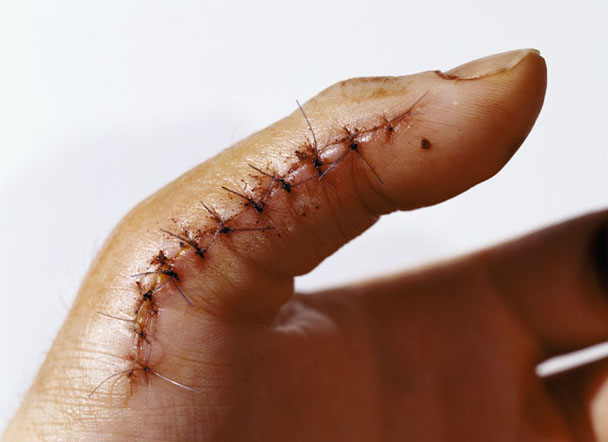Rule No. 1: Never try to catch a falling knife.
It was day two of culinary school. My fellow student’s brand–new nine–inch Wüsthof knife fell from the butcher block in front of him. He reacted in a flash, instinctively extending his hand.
A two–inch laceration poured forth a river of red—on his checkered pants, on his white coat, on his cutting board, on the floor. Blood everywhere. Our chef instructor spotted the mishap out of the corner of his practiced eye: “Someone call 911.”
The result was a severed tendon in the student’s thumb and a dozen or so stitches. A botched suturing job robbed him of feeling in his finger, likely forever.
Between fierce cleavers, bubbling–hot oil, slippery floors, and swirling blades, a kitchen can be a dangerous place. And while minor cuts on fingers and hands are commonplace, there are times when the slipups are more reminiscent of a scene in Grey’s Anatomy.
Chris Gesualdi, a chef instructor at the Institute of Culinary Education in New York City and an experienced restaurant chef, has seen his share of kitchen calamities: blockbuster falls on greasy floors, 25–pound stand mixers crashing to the ground and smashing heads on the way, unattended blenders whizzing hot soup onto unsuspecting faces, and—right out of some crazed cartoon—chefs’ coats turned into candles by a classic flambé.
But by far the worst accident Gesualdi has witnessed—in a New York City restaurant of significant repute, he adds—involves two unlikely partners: naked flesh and hot oil. “One day, a guy was changing the lightbulb up where the [stove] hoods are, and a guy below him was straining the deep–fat fryer oil,” Gesualdi recalls. “The guy changing the lightbulb was getting down, and he stepped directly into the pot of 350–degree oil. It went all the way up from his foot to his knee.” The injury sent him straight to the hospital—for three months.
A hot–oil burn is among the most excruciating of accidents—second only to sticky hot sugar. When bubbling caramel comes into contact with skin, not only does it cause a burn, but it bonds like a barnacle. The pain is agonizing, and the recovery can be just as painful.
Burn wounds linger, often leaving noticeable scars not unlike those resulting from a knife—or, worse, a band saw. “The band saw is a bone cutter, and it’s almost like cutting wood,” says Stanley Lobel, owner of Manhattan’s historic Lobel’s of New York butcher shop. “I’ve never seen [injuries happen] in our shop because we have certain rules you have to follow, but I’ve heard of fingers and hands getting cut very, very severely.”
Butchers are on the front lines of kitchen trauma, of course, surrounded by six–inch meat cleavers, spinning slicers, and churning meat grinders. “Almost all of the old–time butchers I know have lost a piece of their finger,” reports Dario Cecchini, a world–renowned butcher based in Panzano in Chianti, a suburb of Florence, Italy. Cecchini has been wielding a knife for more than 37 years and considers himself lucky: “It’s actually quite a heroic thing that I’ve gotten as far as I have while still having all ten fingers.”
Bad luck and ill timing aside, there are strategic steps to take to keep kitchen accidents at bay. The most important precaution of them all may actually seem like the most counterintuitive. But Gesualdi, Lobel, and Cecchini concur: A very sharp knife is the first safeguard against cutting yourself.
“When you use a sharp knife, you only have to make one or two cuts, maximum,” says Lobel. “Whereas when you use a dull knife, you’re pushing your knife back and forth for a cut that should have been made once or twice. And there’s an inherent chance of it slipping or jerking out of the particular cut you’re doing.” The butchers’ bottom line: Dull knives make you work, while sharp knives do the work for you.
Make sure you are cutting away from your body and stationary hand at all times, Lobel advises. “In other words, if you’re right–handed, the blade should be facing to your right,” and vice versa for left–handers.



 Pinterest
Pinterest


